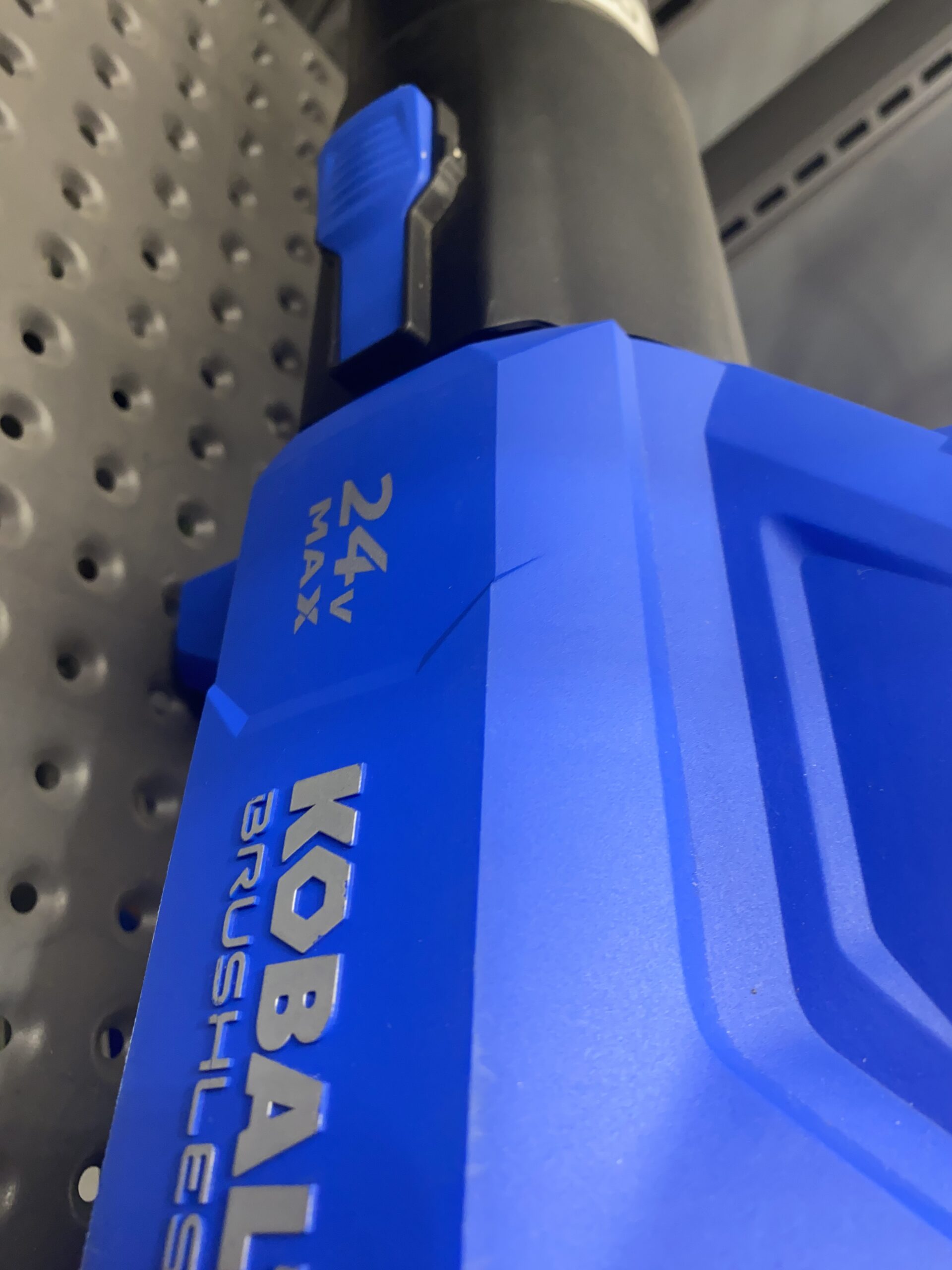Kobalt’s 24V cordless blower is a really nice blower for the average homeowner. I got my hands on this Kobalt blower for some serious testing and have to say – it is super lightweight.
I’ve tested a few Kobalt products in my day and also own their 80V blower. I am always impressed by the build quality of Kobalt products, but they are a company that truly flies under the radar.
Bottom Line: The Kobalt 24V blower isn’t super powerful but it is powerful enough for most homeowners to clean off their porch or driveway without a problem. You can grab it for a really nice price over on Amazon.
Pros of the Kobalt 24V Blower
- Turbo button for additional power
- Really lightweight at just over 5 lbs
- Part of a great battery series
- Brushless motor
- Sleek design and not-too-flashy blue color
Cons of the Kobalt 24V Blower
- Relatively low CFMs and MPH
- Not great for large yards
Looking for more power? Check out our video review of the Kobalt 80V Blower here.
My review of the Kobalt 24V Blower
Right after I picked up my Kobalt 24V blower I took it home and put it through the ringer. Here are some of my observations.
The Kobalt 24V blower isn’t that powerful
Don’t get me wrong, the Kobalt 24V is fine from a power perspective, but compared to some others out there it isn’t very powerful. If you don’t know what the crazy acronyms like CFMs and MPH are, read here.
If you do, the Kobalt 24V blower has up to 500 CFMs and 120 MPH. Mind you, these two specifications are fully maxed out using the Turbo button. Without the turbo button, you’re likely in the 375-400 CFM range and around 100 MPH. This is much more than a light breeze but if you check out some of the more powerful battery powered leaf blowers, you’ll see that there are better options.
The Kobalt 24V blower is perfect for around-the-house activities: blowing off the driveway, back porch, and even moving some smaller piles of leaves. It is not a substitute for a larger backpack blower, however.
Kobalt’s 24V Max Blower is super easy to use
What the Kobalt 24V Max blower lacks in extreme power it makes up for in extreme ease of use. I think this is why Kobalt’s blower is so darn popular – it is super intuitive and can be used by literally anyone with thumbs.
Once you pop on the 24V Max battery, you simply pull the trigger and you’re ready to blow. No maintenance or prep work is required to use this blower. It also has a nice variable speed trigger so you can have complete control over the speed.
What is not missing from the Kobalt 24V Max blower is the cruise control function. Since I didn’t use this for long and probably wouldn’t use it for a long, intense leaf cleaning – it really doesn’t matter. It is there if you want it.
Lastly, this blower comes in at just over 5 lbs. This makes using the Kobalt 24V blower super easy, from directing it wherever you want with ease, to making your shoulder feel normal again.
The Kobalt 24V Max Blower has a durable brushless motor
One thing I love about Kobalt is that they tend to make a bunch of quality products and hardly skimp on the necessities. The brushless motor on the Kobalt 24V Max blower means that the motor has a longer run-time, a cooler running motor, and will last for years longer than a traditional brushed motor.
The Kobalt 24V Max battery line
Kobalt’s 24V Max battery line is extensive. In addition to this blower, I’ve also used the their string trimmer in the same 24V lineup which was super powerful and an amazing tool in my arsenal.
And if you haven’t watched my video test of the Kobalt 80V blower yet – you’ll find out that Kobalt has crazy run-times on their products. Like truly absurdly long run times.
My review: Kobalt 24V Max Blower
While I can’t say the Kobalt 24V leaf blower is right for everyone, it is right for most homeowners. This cordless blower is easy to use, lightweight, and affordable. If you need more power or have a larger yard, I would look elsewhere.
If this sounds like you, check out this blower over on Amazon or at Lowe’s.
How I tested the Kobalt 24V Blower
I tested this Kobalt blower by taking it home, putting it together (took two seconds), and then walking around my yard with the blower on full speed + turbo. I used the Kobalt 24V blower on mulch, grass clippings, leaves, small sticks, and small rocks.
Why we review leaf blowers
Sounds weird, right? But we got burned dozens of times buying crappy lawn tools with impressive sounding specifications. After that happened enough times, I got serious and started to really study electric and battery powered lawn tools. Once I got wise, I started The Lawn Review to help others find lawn tools that are actually good (or bad) and give my honest, unbiased opinion of any tool I come across.
